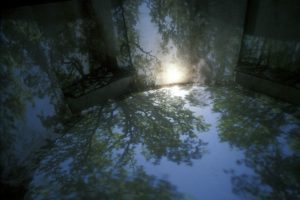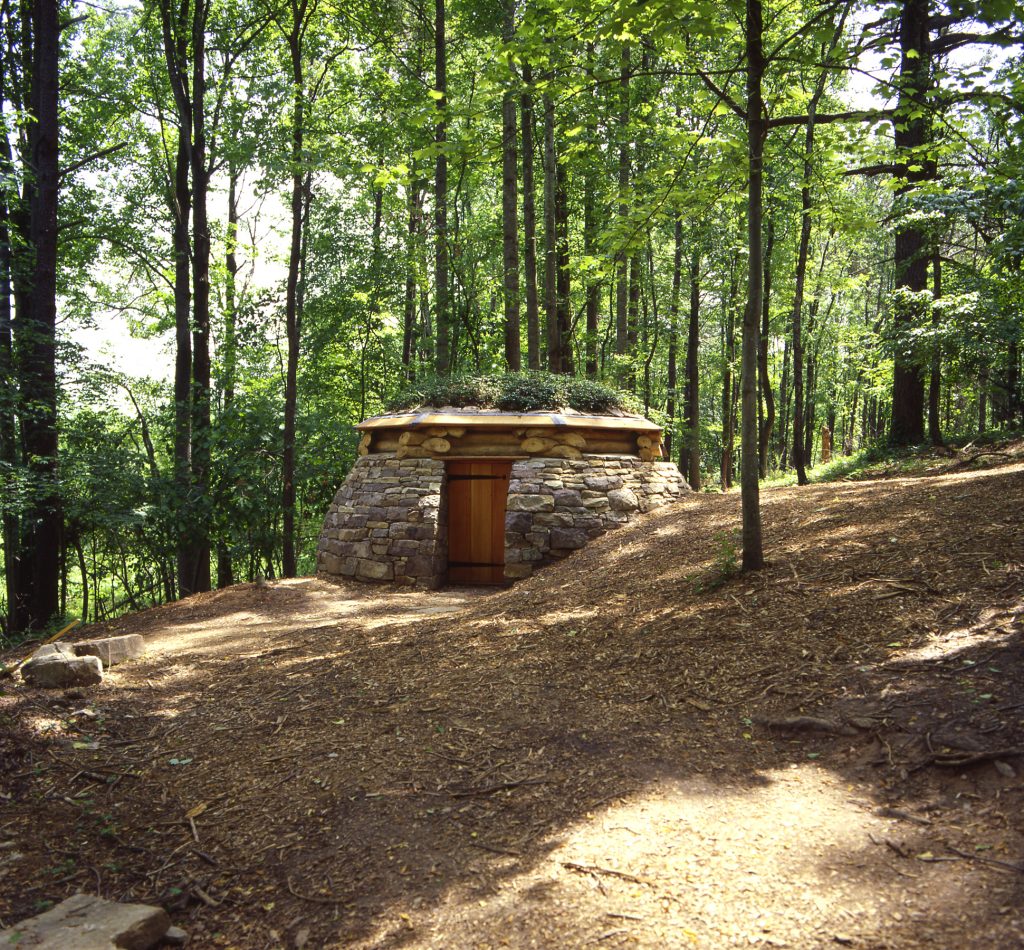The Cloud Chamber Conservation Project (resource)
Cloud Chamber for the Trees and Sky is one of the first site-specific outdoor installations commissioned for the Museum Park, created and constructed in 2003 by the British artist Chris Drury. Located in a wooded area, the partially buried, circular, and roofed structure is built from Virginia fieldstone, yellow pine logs, cement, earth, and plants all local to the southeastern United States. The white-washed interior, accessible via a door, is dark except for a beam of light coming through a small aperture in the ceiling.
Drury’s series includes sixteen cloud chambers built in locations around the world, with only one other in the United States (Vanderbilt University, Brentwood, TN). They are interactive buildings made from natural materials native to the landscape where they are located. The structures are contemplative spaces that invite meditative silence and bring the outside in as visitors look down on the projected sky, trees, and clouds.
Restoring Cloud Chamber for the Trees and Sky
Cloud Chamber for the Trees and Sky is one of the most beloved installations in the Museum Park. After seventeen years of use and environmental exposure, portions of the octagonal roof made of yellow pine were showing severe signs of natural deterioration and rot. Numerous patches and repairs had been done over the years, but more significant work was needed. An important decision had to be made between dismantling the sculpture entirely or undertaking a significant restoration of the wooden roof. After thorough consultation with the artist, Chris Drury, and the NCMA Conservation Department, the Museum decided to move forward with reconstructing the roof.
The consensus was to rebuild the roof with black locust logs, a naturally rot-resistant tree native to the region. The restoration team—composed of Ben Bridgers, manager of Park collection and exhibitions, and Corey Riley, objects conservator—began dismantling the original roof and replicating each element using this new material. We are thrilled that Cloud Chamber for the Trees and Sky, one of the most sought-after interactive installations in the Park, will continue to delight visitors for decades to come.
About the Artist
Based in England, environmental artist Chris Drury creates sculptures in the landscape that have an inherent reciprocity with the natural world. Located in the NCMA’s Museum Park, his Cloud Chamber for the Trees and Sky has an ageless, primal quality, like an ancient ruin or natural formation.
The domed chamber operates as an oversized camera obscura, or pinhole camera. A small aperture in the roof projects an inverted image of the sky and trees above onto the interior floor and walls. Inside the chamber one’s perspective of the world is magically turned upside down. Instead of looking up at the sky—the earthbound view of the world—one sees the sky brought down to Earth, looking down on it from above.
“People who have never experienced being inside cloud chambers sometimes question the difference between looking up at clouds—and seeing the image inside a chamber,” says Drury. “In fact, these experiences are quite distinct … It is an altered image, slightly blurred, dim, like a scene from an old movie or a dream.”
Camera Obscura
Cloud Chamber for the Trees and Sky serves as a camera obscura, a Latin term that means “dark chamber.” A camera obscura is a dark box (or room) with a small hole that acts as a lens or aperture in one of the walls. The image from outside is transmitted through the aperture and projected upside down on the opposite interior wall.
This natural optical phenomenon has been used by scientists and artists for centuries. The earliest known documentation of its use dates to the fifth century bce. The technical principles of the camera obscura led to the early nineteenth-century development of photography.


